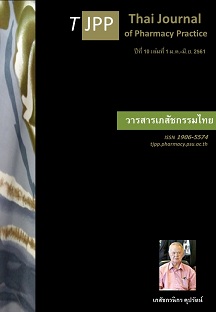คำอธิบายถึงการมียาเหลือใช้และพฤติกรรมในการจัดการยาเหลือใช้ของผู้ป่วยโรคเบาหวาน และโรคความดันโลหิตสูง: กรณีศึกษาในชุมชนแห่งหนึ่งของจังหวัดอุบลราชธานี
Main Article Content
บทคัดย่อ
วัตถุประสงค์: เพื่อศึกษาคำอธิบายถึงการมียาเหลือใช้และพฤติกรรมในการจัดการยาเหลือใช้ของผู้ป่วยโรคเบาหวานชนิดที่ 2 และโรคความดันโลหิตสูงในชุมชนแห่งหนึ่งของจังหวัดอุบลราชธานี วิธีการ: การวิจัยนี้เป็นการศึกษาเชิงคุณภาพโดยเก็บข้อมูลยารักษาโรคเรื้อรังที่เหลือใช้ และสัมภาษณ์แบบกึ่งโครงสร้างในผู้ให้ข้อมูลซึ่งประกอบด้วย ผู้ป่วยจำนวน 40 คน โดยการสัมภาษณ์ที่บ้านของผู้ให้ข้อมูล และเจ้าหน้าที่โรงพยาบาลส่งเสริมสุขภาพตำบลจำนวน 2 คน ผลการวิจัย: คำอธิบายถึงการมียาเหลือใช้ในมุมมองของผู้ป่วย ได้แก่ ผู้ป่วยรับประทานยาไม่ถูกต้องตามแพทย์สั่ง ลืมรับประทานยา และเข้าถึงยาได้หลายช่องทาง คำอธิบายถึงการมียาเหลือใช้ในมุมมองของผู้ให้บริการ ได้แก่ ผู้ป่วยรับยาจากสถานพยาบาลหลายแห่ง ปรับขนาดยาเอง รับประทานยาผิด และสถานพยาบาลจ่ายยาให้ผู้ป่วยเกินวันนัด การจัดการยาเหลือใช้ของผู้ป่วย ได้แก่ เก็บยาเดิมไว้และรับประทานยาใหม่ก่อนยาเดิม กำจัดยาทิ้ง และนำยาไปคืนสถานพยาบาล ผู้ป่วยทุกรายไม่เคยพบยาหมดอายุหรือยาที่มีลักษณะเปลี่ยนแปลงไป แต่หากพบจะมีวิธีการจัดการ ได้แก่ ถามบุคลากรทางการแพทย์หรือส่งคืนโรงพยาบาลส่งเสริมสุขภาพตำบล เก็บยาไว้ รับประทานยาต่อไป ทำลายยา และถามเพื่อนบ้าน ส่วนแนวทางในการจัดการยาเหลือใช้ของเจ้าหน้าที่โรงพยาบาลส่งเสริมสุขภาพตำบลคือปฏิบัติตามนโยบายโดยให้นำยาเหลือใช้มาคืน สรุป: ผลการศึกษาทำให้ทราบคำอธิบายของการมียาเหลือใช้ในมุมมองของผู้ป่วยและผู้ให้บริการ การจัดการยาเหลือใช้ของผู้ป่วยแสดงให้เห็นว่า ผู้ป่วยยังขาดความรู้ในเรื่องนี้ แนวทางการจัดการยาเหลือใช้ของสถานพยาบาลยังได้รับความร่วมมือในระดับต่ำ จึงควรส่งเสริมให้มีมาตรการการนำยาเหลือใช้มาคืนอย่างเป็นรูปธรรมเพื่อช่วยลดปัญหายาเหลือใช้
Article Details
ผลการวิจัยและความคิดเห็นที่ปรากฏในบทความถือเป็นความคิดเห็นและอยู่ในความรับผิดชอบของผู้นิพนธ์ มิใช่ความเห็นหรือความรับผิดชอบของกองบรรณาธิการ หรือคณะเภสัชศาสตร์ มหาวิทยาลัยสงขลานครินทร์ ทั้งนี้ไม่รวมความผิดพลาดอันเกิดจากการพิมพ์ บทความที่ได้รับการเผยแพร่โดยวารสารเภสัชกรรมไทยถือเป็นสิทธิ์ของวารสารฯ
เอกสารอ้างอิง
2. Champunot P. Leftover medicines and medicine use behavior of people in Chiang Mai province. [master thesis]. Chaing Mai: Chaing Mai University; 2012.
3. Papitak K, Apinyapanit T, Boonyawattipong P, Wipat kasamsuk P. Study on cost and the participation in finding of cause and ways to solve unused medicines in patients with diabetes and hyperten- sion: Case study in Makok village, Kantharawichai Maha Sarakham [Pharm D research project]. Maha sarakham: Mahasarakham University; 2013.
4. Bareau of Non Communicable Disease. Non-commu nicable disease data [online]. 2015 [cited Feb 12, 2016]. Available from: thaincd.com/information-sta tistic/non-communicable-disease-data.php?pn=1.
5. Ubon Ratchatihani Provincial Health Office. Health status data in 2015 [online]. 2016 [cited May 1, 2017]. Available from: www.phoubon.in.th/.
6. Anon. Clinical practice guideline for diabetes 2014. Bangkok: National Health Security Office; 2014.
7. Thai Hypertension Society. Thai guidelines on the treatment of hypertension 2012 updated. Bangkok: Thai Hypertension Society; 2015.
8. Thai Health Promotion Foundation. “Unused medicine”: The silent disaster of Thai people’s health [online]. 2010 [cited May 30, 2017]. Available from: www.thaihealth.or.th/Content/5044- "ยาเหลือใช้"_ภัยเงียบสุขภาพคนไทย.html
9. Health Insurance System Research Office. The Pharmacy Council of Thailand indicated that there were unused medicines in 54 communities in Bangkok [online]. 2010 [cited Feb 12, 2016]. Available from: www.hisro.or.th/main/?name=news &file=readnews&id=74.
10. Nimsai W. Amount, price, and cause of diabetic drugs returned by diabetic patients at Bangkhla hospital, Chachoengsao province. Journal of Phra pokklao Nursing College. 2010; 41: 23–31.
11. Nimanong P. Causes and handing of unused medi cines in patient with hypertension at Panthong hospital [online]. Chonburi Provincial Health Office. 2014 [cited Feb 12, 2016]. Available from: www.cb o.moph.go.th/research_n/abst/dspimg.asp?id=231.
12. Suwannaprom P, Niamhun N, Champoonot P, Pho suya C, Chowwanapoonpohn H, Supakul S, et al. Items and value of household leftover medicines for chronic conditions at Sansai-Luang sub-district, Sansai district, Chiang Mai province. Thai Pharma ceutical and Health Science Journal. 2012;25:22–8.
13. Thavornwattanayong W, Jansuriyakul W, Chanpen S, Keesititsombun W, Srinuanrod K. Survey of left- over drug and drug use behavior among patients with chronic diseases in Nong Pak Long, Mueang, Nakhon Pathom. Journal of Health Science. 2012; 126: 1140–7.
14. Sadoyoo S, Jirapreeya N, Treesak C, Sangjam P. Leftover medications in patients with chronic dis- eases from home health care visits: A community study in Bangkok. Dialogue Pharm Health Care Pract. 2014;1:1–7.
15. Pisutthikoson C. Prevalence and factors related to leftover medicine in patient with type 2 diabetes mellitus at Prachasamosorn community medical unit Muang district, Khon Kaen province. [master thesis]. Khon Kaen: Khon Kaen University; 2014.
16. Charoenchokthavee W, Lertwattanachai T, Rodhed bhai W, Kobwanthanakun S. Analysis and manage ment of unused medications problem in urban living area. Vajira Medical Journal. 2013;81:147–60.
17. Savetyotin V. Toxicity of pharmaceutical to the environment. Green research. 2016; 32:11–3.


